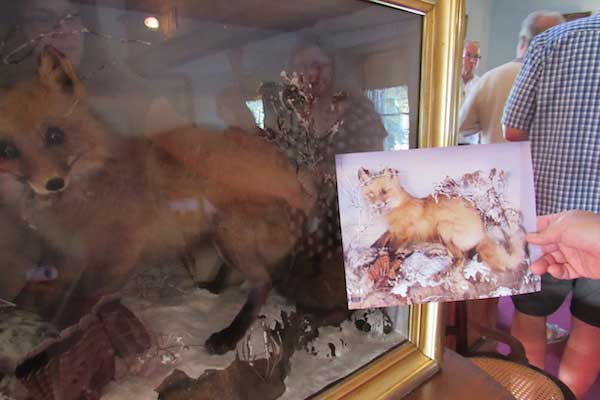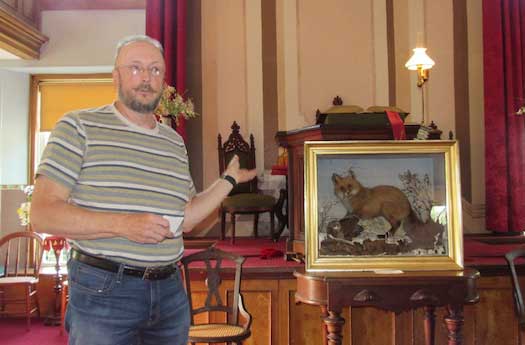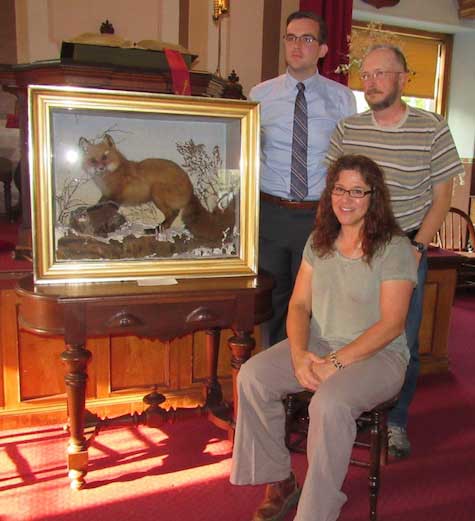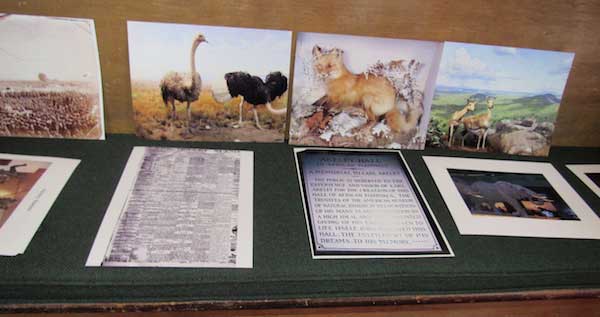Akeley Fox gets big welcome home
Cobblestone Museum, Clarendon Historical Society celebrate ‘world-class restoration effort’
CHILDS – Calling it a “world-class restoration effort,” Cobblestone Museum Director Doug Farley opened a reception at the Cobblestone Church on Ridge Road Saturday afternoon to officially welcome home an early example of the work of famed Clarendon taxidermist Carl Akeley. The reception was held in conjunction with members of the Clarendon Historical Society.
The work – a red fox mounted by Akeley in 1879 at the age of 16 – was recently restored by George Dante, a taxidermist and conservator of Wildlife Preservation in New Jersey.
Farley said the restoration resulted from an “amazing grass-roots effort to secure funding” for the project. Private donors, a grant from the Elizabeth Dye Curtis Foundation and a donations from the Orleans County Chapter of the Daughters of the American Revolution and the Clarendon Historical Society made the project possible, Farley said.
Bill Lattin, retired Orleans County Historian and Cobblestone Museum Director, has a family connection to the fox. He spoke during the reception and explained that his great-grandfather, Francis Harling of Albion, procured the fox for Akeley. Lattin explained that the fox, enclosed in a framed diorama, is a precious artifact.
“In the world of taxidermy, it’s like owning a Rafael,” Lattin said. “It’s very, very special.”
Akeley, (1864-1926), is known as the Father of Modern Taxidermy. He devised a method for fitting an animal’s skin over a meticulously prepared and sculpted form of the animal’s body. The process included the animal’s musculature and details such as wrinkles and veins and produced a very realistic result.
Akeley made many trips to Africa to collect specimens and created the African Hall at the American Museum of Natural History in New York City. Akeley also liked to place the mounted animals in settings that reflected their native habitat.
Lattin said his great-grandfather wanted the fox diorama to display in the family’s home on East County House Road in Albion.
Harling was a middle-class dirt farmer and blacksmith, Lattin explained, but noted it is interesting that, “common ordinary people (of that time) had a sensitivity for aesthetics.” Harling had gone out of his way to procure the fox, Lattin said, so that something beautiful could be made to decorate the family’s home, “that’s remarkable,” he observed.
Now that the fox – which Lattin said was found to be a vixen during the restoration work – can help people today to, “appreciate what our ancestors saw as beautiful.”
Matthew Ballard (Orleans County Historian), Bill Lattin and Melissa Ierlan (Clarendon town historian) pose with Carl Akeley’s fox diorama. Cobblestone Museum officials said those visiting the Cobblestone Church will be able to see the diorama on the lower level where the Museum gift shop is located.
Ballard, the county historian and former Cobblestone Museum director, explained that the effort to have the fox diorama restored was fueled by a celebration held in 2014 by the Clarendon Historical Society for the 150th anniversary of Akeley’s birth.
Jay Kirk, the author of Kingdom Under Glass about Carl Akeley and his work, attended the celebration as did Akeley expert John Janelli.
“We wanted to bring (the fox) to the attention of people who would appreciate Akeley’s work,” Ballard said. “The fox is part of a transitional phase for Akeley.”
Ballard noted the legwork done by Ierlan, the Clarendon historian, to have the fox restored as well as the local fundraising effort.
“It’s surreal to see it come to fruition,” Ballard said of the restoration project. “It’s a piece of national significance.”
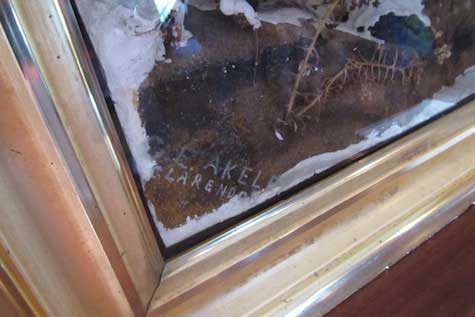
Carl Akeley wrote his name and Clarendon in the bottom left corner of the diorama.
Ierlan discussed Akeley’s life and work from his humble beginnings on Hinds Road in Clarendon to the jungles of Africa.
“He was the original Indiana Jones,” Ierlan said. She noted his early work preserving the pet canary of his aunt, his training in taxidermy by David Bruce in Brockport and his apprenticeship at Ward’s Natural Science Establishment in Rochester.
She explained that the taxidermy work done before Akeley often made animals look like stuffed toys – “freakish and scary…. (Akeley) wanted to make them look as real as possible,” Ierlan said.
In addition to his taxidermy work, Akeley was an accomplished sculptor, biologist, conservationist and inventor with over 29 patents. Akeley improved the motion picture camera for filming animal movement, Ierlan said.
“He had a remarkable life….. he was one of America’s greatest men,” she said.
Melissa Ierlan brought copies of photographs of Akeley’s work including diorama’s from the American Museum of Natural History and the entourage that accompanied Akeley on his African trips to collect specimens (far left), as well as the condition of the fox diorama prior to restoration.

























